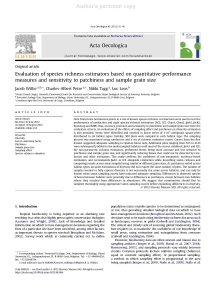Willie J., Petre C.A., Tagg N., Lens L.
Data from forest herbaceous plants in a site of known species richness in Cameroon were used to test the performance of rarefaction and eight species richness estimators (ACE, ICE, Chao1, Chao2, Jack1, Jack2, Bootstrap and MM). Bias, accuracy, precision and sensitivity to patchiness and sample grain size were the evaluation criteria. An evaluation of the effects of sampling effort and patchiness on diversity estimation is also provided. Stems were identified and counted in linear series of 1-m2 contiguous square plots distributed in six habitat types. Initially, 500 plots were sampled in each habitat type. The sampling process was monitored using rarefaction and a set of richness estimator curves. Curves from the first dataset suggested adequate sampling in riparian forest only. Additional plots ranging from 523 to 2143 were subsequently added in the undersampled habitats until most of the curves stabilized. Jack1 and ICE, the non-parametric richness estimators, performed better, being more accurate and less sensitive to patchiness and sample grain size, and significantly reducing biases that could not be detected by rarefaction and other estimators. This study confirms the usefulness of non-parametric incidence-based estimators, and recommends Jack1 or ICE alongside rarefaction while describing taxon richness and comparing results across areas sampled using similar or different grain sizes. As patchiness varied across habitat types, accurate estimations of diversity did not require the same number of plots. The number of samples needed to fully capture diversity is not necessarily the same across habitats, and can only be known when taxon sampling curves have indicated adequate sampling. Differences in observed species richness between habitats were generally due to differences in patchiness, except between two habitats where they resulted from differences in abundance. We suggest that …. Copyright 2012 Elsevier Masson SAS. All rights reserved
Consultez la notice complète de l’article sur ORBi

